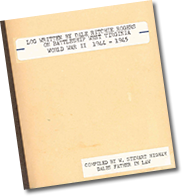View larger map
Sailing on August 3 for Okinawa, West Virginia reached Buckner Bay on the 6th, the same day that the first atomic bomb was dropped on the city of Hiroshima. Three days later, a second bomb obliterated the greater part of the city of Nagasaki. Those two events hastened Japan’s collapse. On August 10, at 2115, West Virginia picked up a garbled report on radio that the Japanese government had agreed to surrender under the terms of the Potsdam Declaration, provided that they could keep the Emperor as their ruler. The American ships in Buckner Bay soon commenced celebrating–the indiscriminate use of antiaircraft fire and pyrotechnics (not only from the naval vessels in the bay but from marines and Army troops ashore) endangering friendly planes. Such celebrations, however, proved premature–at 2004 on August 12, West Virginia sailors felt a heavy underwater explosion; soon thereafter, at 2058, the battleship intercepted a radio dispatch fromPennsylvania (BB-38) reporting that she had been torpedoed. West Virginia sent over a whaleboat at 0023 on the 13th with pumps for the damagedPennsylvania.



